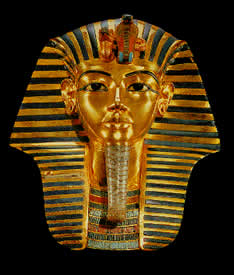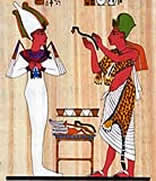
| Make your own Cartouche |
|---|
| Tutankhamen |
| Egypt Games |
| Mummy Maker |
| Egypt Map |
| Travel to Egypt |
| © 2005 W.D Paterson |


The Mask of Tutankhamen
The Life of King Tutankhamen
In 1323 B.C., a young Egyptian king died. His name was Tut.ankh.Amum . Tutankhamen is the best-known pharaoh of ancient Egypt. He was probably the son of Akhenaten, the heretic king of the eighteenth dynasty. His mother was probably Queen Kiya, one of the king's secondary wives. Ankhesenpaaten (or Ankhesenamum), his older half sister, became his queen. He ascended the throne in 1333 B.C., at the age of nine, and reigned until his early death at the age of seventeen or eighteen. Some speculate that he was murdered and others think he may have been deliberately sent into battle to be killed. However, the exact cause of his death is unknown. Those who believe he was murdered point to the bone fragments in his skull as evidence, but some experts believe the fragments were from the tip of his neck bone and may have been caused after his death. His mummified body was so badly preserved that we may never know the true fate of this minor pharaoh.
The discovery of Tutankhamen's tomb by Howard Carter in 1922 is considered the most important archaeological find of the century. After years of blood sweat and tears working in the Valley of the Kings, Carter's patron, Lord Carnarvon, had warned him that this would be the last season of work because nothing significant had been found. On November 22 of that year, Carter's persistence finally paid off. Tutankhamen became a household name, and his magnificent treasures became the measuring stick for all future archaeological discoveries. The mysteries surrounding his life and death are gradually being solved. And his story continues to unfold as new theories are proposed in an attempt to explain what really happened to the boy behind the golden mask.
Researchers continue to investigate the cause of Tutankhamen's premature death. Bob Brier, a mummy specialist from Long Island University, has been tracking down clues that indicate Tutankhamen may have been killed by his elderly chief advisor and successor, Ay. An X-ray of his skull revealed a calcified blood clot at its base. This could have been caused by a blow from a blunt implement, which eventually resulted in death. Even newer evidence suggests that Tutankhamen may not have been killed. He was thought to have a severe curvature of the spine but this curve was probably caused by the mummification process. No real physical defects could be found although his rib cage had been cut by a saw around the heart area, but again this was probably the work of the embalmers.
After studying the evidence he may have been poisoned or suffocated. He seemed to be a healthy boned individual at the prime of his life. Ay had the most to gain from his death and if Tutankhamen was killed it would most probably would have been Ay that instigated it.

(Left)King Tutankhamen & Ay
The Mummy's Curse
The Egyptians were preoccupied with the cult of the dead. The mummified bodies of kings and followers were placed in tombs filled with all the necessities of life. To protect the deceased in the afterlife and to prevent robbers or political enemies from desecrating the burials, the tombs were hidden in out-of-the-way places and a curse was invoked against violators.
The belief in the mummy's curse was rekindled when Lord Carnarvon, patron of Howard Carter's archaeological excavations, died five months after the discovery of Tutankhamen's tomb. He died of blood poisoning following a mosquito bite that became infected. Some believe that tiny micro organisms that lay dormant for thousand's of years may have been reanimated due to the opening of the tomb and some of the deaths surrounding the excavation of King Tut's tomb may have been caused by exposure to their dust.
Cairo | History | FAQ | Pictures | News | ContactUs | Hieroglyphics Gamezone | Quiz | Home
